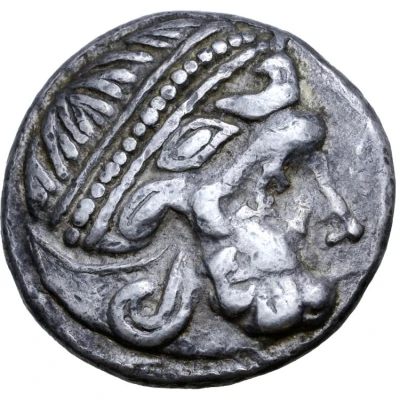


© Roma Numismatics Limited
Tetradrachm Entenschnabel Type 300 BC - 201 BC
| Silver | 14.04 g | 20 mm |
| Issuer | Uncertain Eastern European Celts (Uncertain Central and Eastern European Celts) |
|---|---|
| Type | Standard circulation coin |
| Years | 300 BC - 201 BC |
| Value | Tetradrachm (4) |
| Currency | Drachm |
| Composition | Silver |
| Weight | 14.04 g |
| Diameter | 20 mm |
| Shape | Round (irregular) |
| Technique | Hammered |
| Orientation | Variable alignment ↺ |
| Demonetized | Yes |
| Updated | 2024-10-09 |
| Numista | N#190866 |
|---|---|
| Rarity index | 100% |
Reverse
Stylised rider on horseback to right; fetter below.
Comment
Examples of this type:• Example #1 (14.04g, 20mm, 12h; Good Very Fine) - In main image
© Image courtesy of Roma Numismatics
◦ Ex-Hermann Lanz Collection; published in Kostial #550;
◦ Exhibited by the Staatlichen Münzsammlung München at the 1997 International Numismatic Congress in Berlin; at the Berliner Bank also in 1997; also exhibited at the Luitpoldblock Palmengarten, Munich in 2003 (exhibition #96[obverse]);
◦ Auctioned by Roma Numismatics Ltd, Auction XVIII, 29 September 2019, lot 142. Sold for 2,200 GBP.
◦ Auctioned by Schweizerische Kreditanstalt, Auction 1, 22 April 1983, lot 16.
• Example #2 (14.57g, 19mm, 12h; Very Fine) - In main image
© Image courtesy of Roma Numismatics
◦ Ex-Hermann Lanz Collection; published in Kostial #549;
◦ Exhibited by the Staatlichen Münzsammlung München at the 1997 International Numismatic Congress in Berlin; at the Berliner Bank also in 1997; also exhibited at the Luitpoldblock Palmengarten, Munich in 2003 (exhibition #96[reverse]);
◦ Auctioned by Roma Numismatics Ltd, Auction XVIII, 29 September 2019, lot 145. Sold for 1,100 GBP.
◦ Auctioned by Giessener Münzhandlung GmbH, Auction 40, 7 April 1988, lot 30.
Interesting fact
One interesting fact about the Tetradrachm (Entenschnabel Type) coin from Uncertain Eastern European Celts is that it features a unique design element known as the "entenschnabel" or "goose neck" motif, which is a stylized representation of a bird's head and neck. This design element is found on the coin's obverse (front side) and is believed to have been inspired by ancient Greek coinage. The use of this motif on the Tetradrachm coin suggests that the Celts of this region were influenced by Greek culture and traded with Greek cities.



